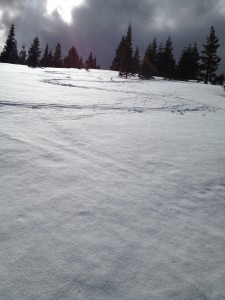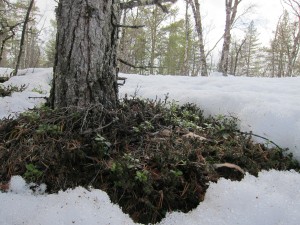 Right now, the meteorological event that some are calling Winter Storm Kayla is on its way across the U.S. While people may be curled up inside with a quilt by the fire, another group of creatures is finding shelter outside, under a cold, white blanket. This post about that unique below-the-snow spot, called the subnivium, originally ran in June 2013.
Right now, the meteorological event that some are calling Winter Storm Kayla is on its way across the U.S. While people may be curled up inside with a quilt by the fire, another group of creatures is finding shelter outside, under a cold, white blanket. This post about that unique below-the-snow spot, called the subnivium, originally ran in June 2013.
**
When I think about winter, I mostly think about all the fun things that take place on the snow’s surface. Or all the fun things that take place inside: hot chocolate, eating, reading by the fire. Once spring comes, when the world outside is buzzing (and boing-ing), there’s no excuse to stay inside with a good book.
I’m not the only one who needs a winter retreat. In snow-covered spots food can be scarce; the wind-chilled open air is brutal. But for creatures that aren’t able to curl up with cocoa, the snow itself forms the insulation for a shelter under the snow.
This below-snow retreat is such a wintertime ecological haven—for everything from freeze-resistant invertebrates that can supercool their own bodies to martens and weasels that stalk prey and snooze in this space–that a paper in this month’s Frontiers in Ecology and the Environment proposes that it should get its own designation: the subnivium. Jonathan Pauli and Benjamin Zuckerberg at the University of Wisconsin-Madison and their colleagues have gotten interested in the dynamics of this sub-snow world—and what will happen to it as winters warm up.
In the upper Midwest, whole weeks have started to vanish from the tail end of winter. While the subnivium has been a stable retreat spot, rising above-ground temperatures will likely make sub-snow life much more unpredictable, Zuckerberg says.
Species that don’t tolerate change well might struggle to survive. Even ones that can roll with the punches will have different challenges—voles and shrews, for example, may need to boost their food intake if they can’t depend on the subnivium as a place to conserve energy.
The pair and their colleagues are figuring out ways to study this hidden layer, and to forecast how it might change in the future. One of the things they’ve got planned: setting up micro-greenhouses and manipulating the subnivium to see the effects on what lies beneath. Someday, they hope, protecting the subnivium may feature in conservation plans.
“When people look out their kitchen windows in the winter, what’s out there looks simple,” Pauli says. “But what happens under the snow is really complex and interesting.”
**
Photo of melting snow by Helen Fields.
One thought on “Redux: Below the Snow”
Comments are closed.